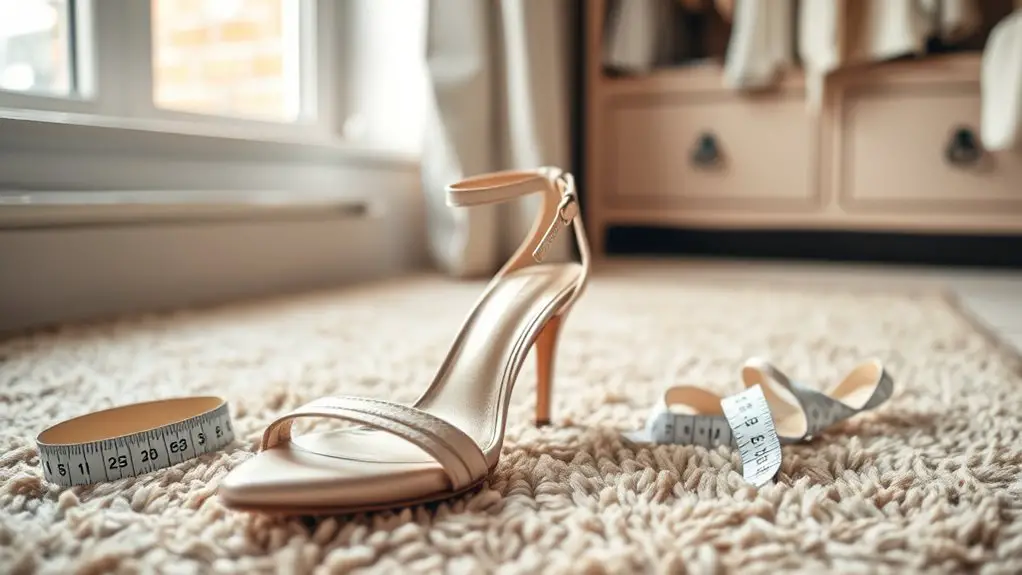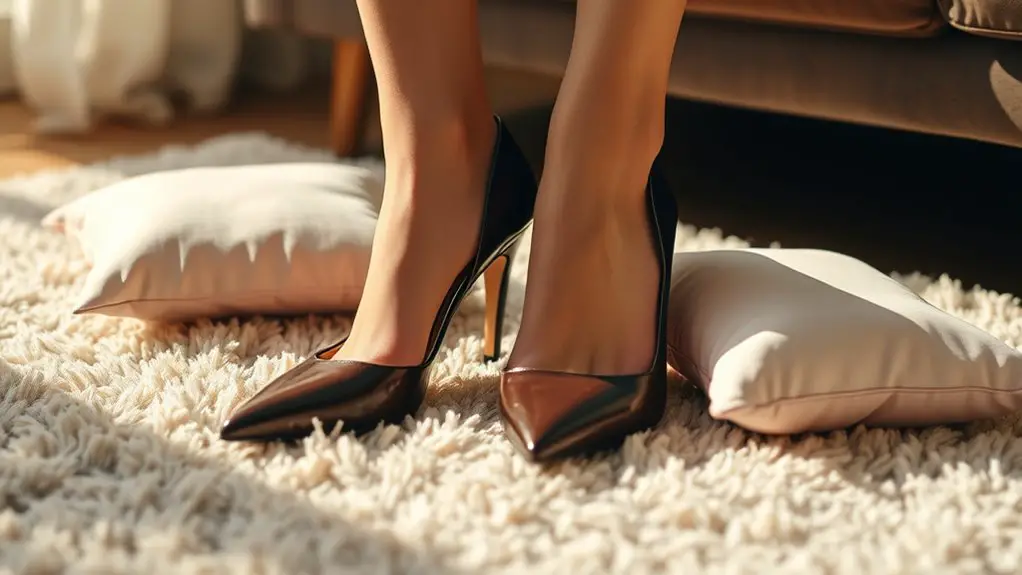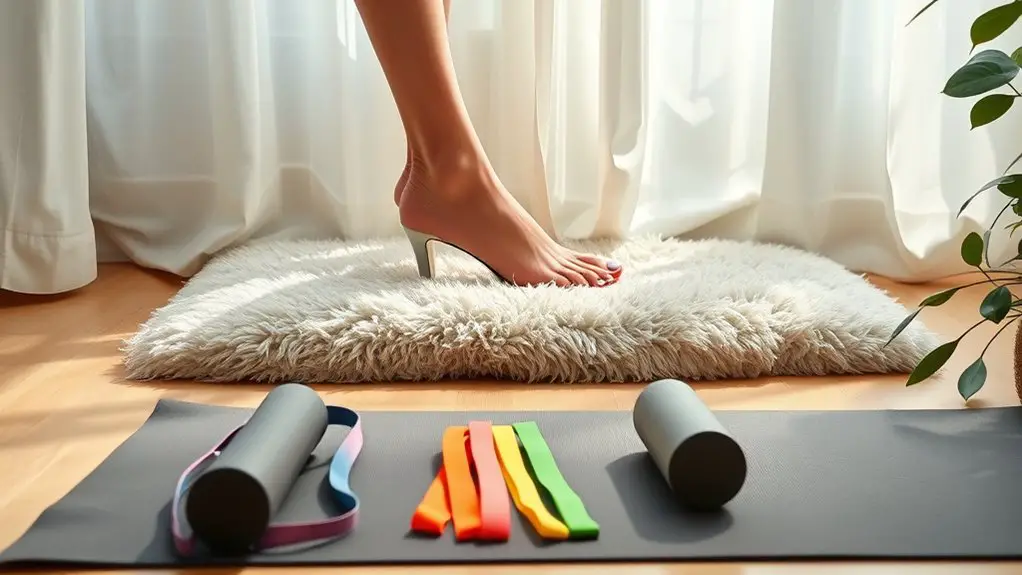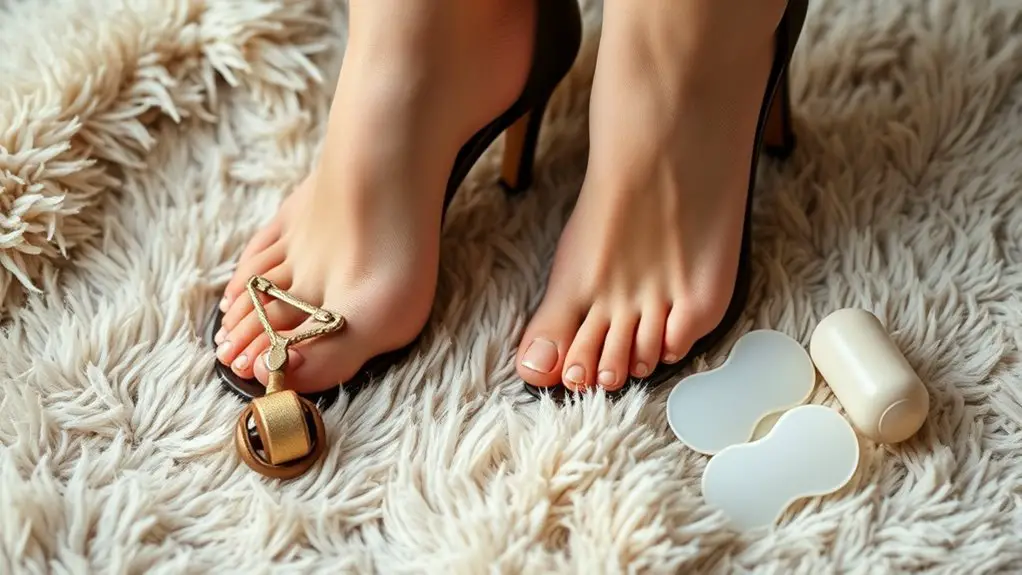To reduce toe pain when wearing high heels, focus on choosing the right size and fit, as shoe sizes can vary by brand. Opt for lower heel heights (2 inches or less) and look for shoes with a wider toe box to allow for natural toe movement. Consider using gel inserts for added cushioning and support. Remember to break in new shoes gradually and incorporate foot exercises. There are more strategies you can explore to further alleviate discomfort.
Choose the Right Size and Fit

Choosing the right size and fit is vital for alleviating toe pain when wearing high heels. Start with an accurate size measurement; this usually involves measuring both your foot length and width. It’s important to understand that shoe sizes can vary by brand, so don’t rely solely on one size.
Next, conduct a fit assessment by trying on the shoes at the end of the day when your feet are slightly swollen, mimicking the conditions they’ll be in during wear. Make sure there’s enough space in the toe box; your toes should not feel cramped. Pay attention to the arch support and heel placement as well—loose heels can cause friction, while overly tight fits can exacerbate pain.
Opt for a Lower Heel Height
When selecting high heels, opting for a lower heel height can greatly alleviate toe pain. You should consider comfortable styles and heel shapes that distribute weight evenly. It’s also crucial to test the shoes before purchasing to guarantee they meet your comfort needs.
Choose Comfortable Styles
While high heels can enhance your outfit, opting for a lower heel height can greatly alleviate toe pain. Selecting shoes with a heel height of two inches or less reduces the pressure on your toes and the balls of your feet. When considering comfortable styles, focus on fashion trends that prioritize both aesthetics and foot health. Look for designs that incorporate softer materials, such as leather or suede, which offer better flexibility and cushioning. Additionally, guarantee the shoe has adequate arch support, as this can further minimize discomfort. By making informed material choices and selecting lower heel heights, you’ll not only keep up with current fashion trends but also protect your feet from unnecessary pain.
Consider Heel Shape
Heel shape plays an essential role in determining the level of comfort you’ll experience in high heels. Opting for a lower heel height can greatly alleviate toe pain, as it promotes better weight distribution and reduces pressure on the forefoot. When selecting heels, consider the following aspects of heel design:
- Heel Height: Aim for a height of 2 inches or less to maintain natural foot alignment and comfort.
- Wider Base: Choose heels with a broader base for enhanced stability and support.
- Arch Support: Look for designs that incorporate adequate arch support to reduce strain on your feet.
Test Before Buying
Testing shoes before purchasing is essential to ensuring comfort and minimizing toe pain, especially when opting for a lower heel height. When you’re trying on heels, take the time to give them a proper test drive. Walk around the store, noting how your feet feel in different styles. Lower heel heights can greatly reduce pressure on your toes, making them a preferable choice if you’re prone to discomfort. Consider your style preference while trying on various pairs, but prioritize fit and comfort over aesthetics. Pay attention to any pinching or discomfort during your test drive, as this can indicate potential issues. Remember, a well-fitted shoe can help prevent long-term foot problems, ensuring you enjoy your favorite styles without pain.
Select Shoes With a Wider Toe Box
Selecting shoes with a wider toe box is essential for minimizing discomfort when wearing high heels. A broader toe box allows your toes to spread naturally, reducing pressure and pain. When shopping, consider the following factors:
- Shoe Materials: Opt for flexible materials like leather or soft synthetic fabrics that can accommodate your foot’s shape.
- Design Features: Look for styles with a rounded or almond-shaped toe box, which offers more room compared to pointed designs.
- Sizing: Make sure to try on shoes in the late afternoon when your feet are slightly swollen, ensuring a better fit.
Use Gel Inserts and Cushions

Using gel inserts and cushions can greatly alleviate toe pain when wearing high heels. Various gel types, such as silicone and gel foam, offer targeted support and can reduce pressure on your toes. Cushion materials like memory foam or latex provide additional comfort, absorbing shock with each step.
| Gel Type | Cushion Material | Benefits |
|---|---|---|
| Silicone | Memory Foam | Superior shock absorption |
| Gel Foam | Latex | Enhanced comfort |
| Hybrid | Gel & Foam | Balanced support |
Incorporating these inserts into your heels helps distribute weight more evenly, preventing excessive pressure on the forefoot. The right combination of gel types and cushion materials can make a significant difference in your comfort level, allowing you to enjoy wearing high heels without the debilitating toe pain. By investing in quality inserts, you’re prioritizing both style and foot health.
Break in Your Heels Gradually
To reduce toe pain in high heels, it is crucial to break them in gradually. Start by wearing your new heels for short periods, allowing your feet to adjust. Alternating with flats can help minimize discomfort and prevent excessive strain on your toes.
Start With Short Wear
Starting with short wear is essential when breaking in new high heels. This approach allows your feet to adjust to the shoe’s structure without excessive strain. To do this effectively, follow these steps:
- Limit Initial Wear: Start by wearing your heels for just 30 minutes to an hour.
- Choose Comfortable Settings: Wear them at home or during low-impact activities to minimize stress on your feet.
- Gradually Increase Time: Each day, extend the time you wear your heels by 15-30 minutes, allowing your feet to adapt fully.
Alternate With Flats
Alternating between high heels and flats is a practical strategy for breaking in your new footwear while minimizing toe pain. Wearing flats allows your feet to recover from the pressure and discomfort that high heels can cause. The flats benefits include improved comfort and increased stability, reducing the risk of developing blisters or bunions. Additionally, flats serve as stylish alternatives that can complement various outfits, ensuring you remain fashionable while prioritizing foot health. Gradually incorporating high heels into your routine, alongside regular use of flats, helps your feet adjust to the heels’ height and structure. This balanced approach not only enhances comfort but also supports long-term foot health, making your high-heel experience more enjoyable.
Incorporate Foot Exercises and Stretches

Although high heels can enhance your appearance, they often lead to discomfort, making it essential to incorporate foot exercises and stretches into your routine. Regularly performing these exercises can help alleviate toe pain and strengthen your feet. Consider the following:
High heels enhance your look but can cause discomfort; foot exercises are vital for relief and strength.
- Toe Stretches: Sit down and extend your legs. Pull your toes back gently using your hands to stretch the muscles and ligaments. Hold for 15-30 seconds.
- Heel Raises: Stand with your feet hip-width apart. Slowly raise your heels, balancing on your toes. Hold for a few seconds, then lower. Repeat this 10-15 times to strengthen the calves and improve stability.
- Foot Roll: Use a tennis ball or a foam roller under your foot to massage the arch. Roll back and forth for 1-2 minutes to alleviate tension.
Incorporating these exercises into your daily routine can greatly improve your comfort while wearing high heels.
Limit Wear Time and Take Breaks
To prevent toe pain while wearing high heels, it’s crucial to limit your wear time and incorporate regular breaks. Extended periods in high heels can lead to discomfort and exacerbate foot issues. By managing how long you wear these shoes, you’re actively practicing pain management.
| Wear Time | Recommended Break |
|---|---|
| 1-2 hours | 10-15 minutes |
| 2-4 hours | 20-30 minutes |
| 4+ hours | 30-60 minutes |
| Special Events | Switch to heel alternatives when possible |
During breaks, take off your heels and allow your feet to rest. Consider heel alternatives, such as stylish flats, to give your feet a reprieve. This approach not only alleviates discomfort but also helps maintain foot health over time. Prioritizing breaks can greatly enhance your experience in high heels.
Consider Professional Foot Care Solutions
If you’re struggling with persistent toe pain from high heels, seeking professional foot care solutions can be a beneficial step. Consulting with foot specialists can provide you with targeted advice and options tailored to your specific needs. Here are three professional solutions to ponder:
- Custom Orthotics: These are specially made insoles that support your foot’s structure, reducing pressure on your toes while wearing high heels.
- Foot Assessments: A thorough examination by a foot specialist can identify underlying issues, such as bunions or neuromas, that contribute to your pain.
- Physical Therapy: Engaging in physical therapy can strengthen foot muscles and improve flexibility, helping to alleviate pain and prevent future discomfort.
Frequently Asked Questions
Can Toe Pain Be Caused by Other Foot Conditions?
Did you know about 30% of adults suffer from foot conditions? Toe pain can indeed stem from issues like bunions or neuropathy. Seeking bunions treatment and understanding neuropathy causes can help alleviate your discomfort effectively.
How Do I Know if My Heels Are Too Tight?
To determine if your heels are too tight, assess for toe discomfort after wear. Fitting guidelines suggest your toes should have space to move without cramping, and the shoe shouldn’t pinch or squeeze your feet.
Are There Specific Brands Known for Comfort in High Heels?
When searching for high heels, consider comfort brands that incorporate advanced heel technology. Brands like Clarks, Naturalizer, and Cole Haan focus on comfort features, ensuring your feet feel better after a long day of wear.
What Are the Long-Term Effects of Wearing High Heels?
Wearing high heels long-term can lead to foot deformities, such as bunions and hammertoes, and increase joint pain, particularly in the knees and hips. It’s essential to reflect on these risks when choosing footwear.
Is It Safe to Wear High Heels During Pregnancy?
It’s generally not advised to wear high heels during pregnancy due to pregnancy discomfort. Consider heel alternatives like supportive flats or low-heeled shoes to guarantee comfort and reduce strain on your body during this time.



